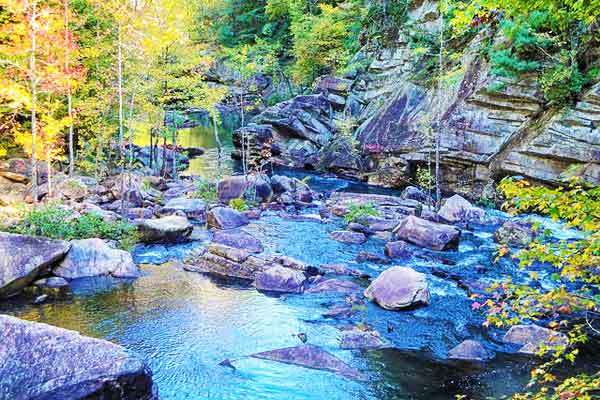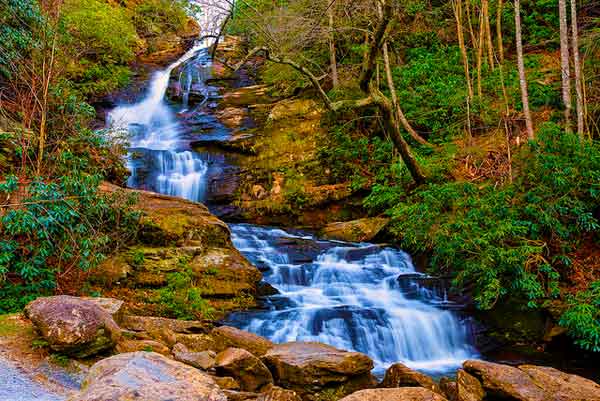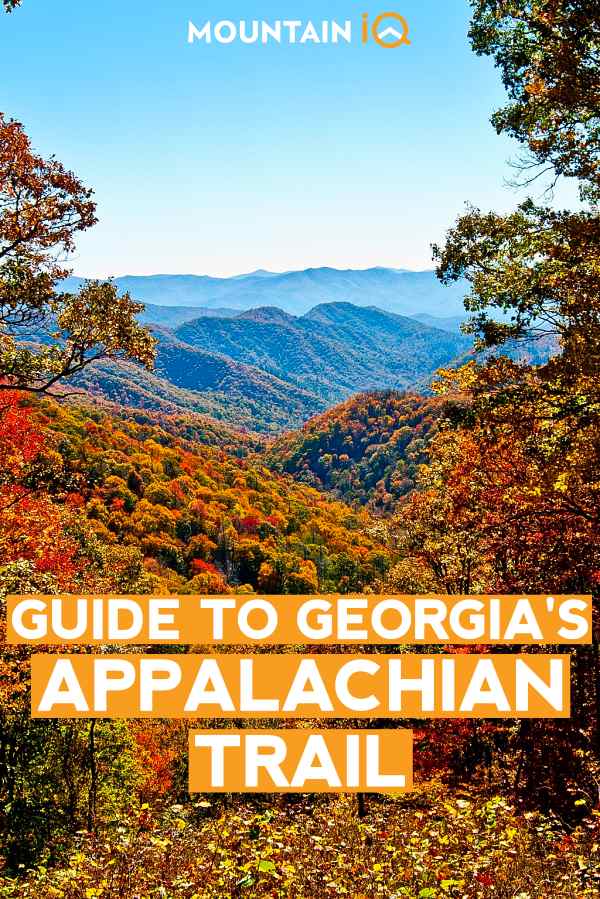The Georgia section of the Appalachian Trail is perhaps one of the most popular sections.
This guide will provide you with all you need to know before visiting the Appalachian Trail.
Typical Georgia AT Itinerary
Getting to the Trail
If you’re driving your car, you can either park at Amicalola State Park or the Springer Mountain trailhead.
After finishing the hike, you can take a shuttle back to your car or hitch-hike.
If you’re flying into the Atlanta airport, there are several options for trail shuttle services that will drop you off at the trailhead.

Amicalola State Park Approach Trail (optional)
Many hikers choose to do the 8.8 mile approach trail. It’s not officially part of the Appalachian Trail and is optional.
Reasons to do it would be because it’s easy to get to than Springer Mountain and there’s a beautiful waterfall along the way.
A reason not to do it would be because it just might be the toughest section of trail in Georgia.
You may also like: hikes in Georgia
Day 1: Springer Mountain to Hawk Mountain Shelter (8.5 miles)
Day 2: Hawk Mountain Shelter to Gooch Mountain Shelter (7.7 miles)
Day 3: Gooch Mountain Shelter to Lance Creek (8.5 miles)
Day 4: Lance Creek to Neels Gap (7.4 miles)
Day 5: Neels Gap to Low Gap Shelter (11.5 miles)
Day 6: Low Gap Shelter to Rocky Mountain (11.1 miles)
Day 7: Rocky Mountain to Sassafras Gap (9 miles)
Day 8: Sassafras Gap to Hiawassee (6.3 miles)
Day 9: Hiawassee to GA/NC Border (8.9 miles)
Guides & Accommodation
Guides: Hiring guides for the Appalachian Trail isn’t really a thing. There are a few trekking companies out there who will take you out for a few days and teach you the ropes. For the most part, the majority of hikers go guide-less, even the brand new hikers.
Accommodation: Hostels or hotels can be found in the towns and locations of Suches, Neels Gap, Helen, and Hiawassee. These are also places where you can resupply on food. When you’re not splurging on a hotel in town, you will be camping along the trail at shelter areas and campsites.
Best Time to Go & Difficulty
Best Time: Hike the Georgia section of the Appalachian Trail in the spring or autumn. The summer will be unbearably hot and humid. Spring and autumn will have much cooler temperatures.
Difficulty: This is a strenuous hike with drastic elevation changes. Rain and thunderstorms are common in the spring. Even though it’s Georgia, winter weather conditions are possible in the mountains. Black bear sightings occur regularly. Food must be stored properly at night.
Cost & Permits
Permits: There are no permits required to hike this section of trail.
Cost of Hiking AT in Georgia: This really depends on how much time you spend in town. The less you are in trail towns, the fewer opportunities you have to spend money. Factor in a necessary resupply on food during this time that may cost $30-50.
If you want to spend the night in a hostel and have a shower, that will be $20. It will cost more if you want your own hotel room. Then there’s the allure of eating at a restaurant in town, which will cost anywhere from $10-30 depending on where you go and what you order.
Essentially, if you want to save money and have an inexpensive hike then you can certainly make that happen in Georgia. If you want to indulge in towns, that is possible as well.
Benefits & Challenges of Hiking AT in Georgia

Benefits
The mountains are big. This means you’ll have amazing views and really feel like you’ve accomplished something when you make it to the top.
There are lots of shelters and campsites for hikers. Since this section of trail gets so many hikers beginning their thru-hikes, it’s set up well to accommodate everyone. You won’t have to worry about not making it to a shelter or campsite in Georgia because they’re everywhere.
In addition to the trail being set up for hikers, so are the towns. You’ll be able to find most anything you need in towns, in terms of gear and food.
The locals are accustomed to hikers and will go out of their way to give you a ride or help you out. Southern hospitality is in full effect in the Georgia section.
You get to see some famous trail spots in the Appalachian mountain range. What hopeful Appalachian Trail hiker hasn’t heard of Neel’s Gap in Georgia?
It’s a gear shop and hostel that is right in the middle of trail. You literally have to walk through the property on your hike. Not to mention hiking up Blood Mountain, a historical site that is rich in Native American legend.
Challenges
Along with the mountains being big, they are also challenging to hike.
The trail is constantly full of steep ups and downs. The Georgia section is not easy. Expect to make low mileage.
While most resources say that 12-15 miles a day is average on the Appalachian Trail, that’s not the case here. If you’re new to hiking, plan on doing 7 or 8 miles a day in Georgia, maybe 10 if you’re feeling exceptionally motivated.
If you choose to come here in the spring, it’s going to be crowded. March and April is when all the thru-hikers are descending upon Georgia.
There was one campsite where I struggled to find a flat tent spot because everywhere else was taken. It’s definitely not a tranquil wilderness experience.
Pro Tip
Get your gear in the pack and go for a short hike with it prior to getting to Georgia. Ensure that you have it as light as possible, ideally under 10kg.
See our Appalachian trekking gear list here it should help you select only the must-have items!
Training For The Trek
The best way to learn how far the AT trek in Georgia USA is going to test your physical ability, is to go on some day-long hikes in your own country.
This will also allow you to break in your hiking shoes and increase your fitness level.
For your exercise routine, we recommend building a combination of hiking, cycling, swimming or rowing to get your heart rate up three times a week.
For aerobic exercise, it is important that you build endurance rather than run at a high intensity so for example if you are planning on jogging, running 5km -10km about 3 times a week at a consistent pace should be the intensity that you are aiming for.
Recommended Guidebook
The Appalachian Trail Conservancy and the Appalachian Long Distance Hikers Association work together every year to create the most up-to-date guide on the Appalachian Trail. It is called Appalachian Trail Thru-Hiker's Companion.
In 2019 they included 50 updated maps, professionally crafted elevation profiles, and comprehensive tables for more easy access to the information while trekking.
It works both for thru-hikers and those who only want to trek a section or two.




Thank you for this guide! I recently attempted a SOBO (and failed due to the mental challenge, not the physical). As a way to rebuild my shattered confidence, I want to do Springer to Franklin, NC, in early October. After I fly into Atlanta, take a subway, then shuttle to Amicalola, I doubt I will be up to hiking the entire approach trail. Where would you recommend camping that first night between the visitor center and Springer? Also, where would be the first resupply town, so I don’t pack my fears of too much food? Will there be other hikers this time of year? Thank you for any advice you can offer!
Hi Marianna, thanks for getting in touch. I’m not 100% sure on the answers to your questions. I highly recommend this forum though: https://www.whiteblaze.net/forum/forumdisplay.php/56-Appalachian-Trail-Forums
Hey Megan. Tha am for the great review. My husband and I did the approach trail last weekend then came back down to hike inn for the night before hiking back out. I want to come back and do a few more sections. One challenge we found was water sources. There was only two on the approach and they were about 2/3 the way thru and barely a trickle. There was none at the top of springer as it was dried up. Is there a resources showing water locations so I can plan ahead? That’s my only concern
Hi Stacey, thanks for getting in touch. I’m not sure on resources for water locations, but I recommend asking in this forum as I’m sure somewhere there can answer your question: https://www.whiteblaze.net/forum/forumdisplay.php/56-Appalachian-Trail-Forums
Are shuttles back to your vehicles available at every stop? Do you need to make reservations ahead of time?
Hi Sandy, I recommend checking out this site for details on shuttles: https://georgia-atclub.org/hike-the-a-t/hike-the-georgia-appalachian-trail/directions-shuttles-parking
Thank you Megan for this very nicely done guide. Its exactly what I was looking for.
I'm thinking of doing the first 50 miles but once I saw how well you have laid it out I'm considering the whole GA section. For the past four years I have done a physical challenge, as a way of staying motivated to fight depression. This will be my most challenging to date. Mentally and physically, that's why I'm thinking of it.
My husband and I hike our local state park, I ride a stationary bike 5 miles daily( high intensity just to say its not just leasure). That's my challenge this year 1200 miles in a year.
Anyway, is there any other tips other than the ones you mentioned. Type of shoe, brand of bag etc.
I'm super nervous bc there is so much mentally at stake. I'm an abuse survivor and this really triggers some things as did my very first challenge I did, a half marathon. I walked. But I finished and in my goal time too. The mountainous terrain is what gets me, mentally. Can I do it? Will I be strong enough? All things I was told I'm not.
I'm sure that's more info than you all want but its honest.
I'm strongly going to think and pray about this. I'm thinking of fall 2024. We are summer missionaries and this gives us time to get home and ready. And a whole year to train.
If you have any advice or recommendations I'd love them. Thank you again
Blessings
Hi Odessa, thanks for your email. It’s difficult to assess your fitness level over the internet, but I think with the right level of training and mental preparedness you can do it! I. recommend checking out this site – it’s got great information and a forum for like-minded thru-hikers: https://www.whiteblaze.net/forum/forumdisplay.php/56-Appalachian-Trail-Forums
Thank you, Mark.
When I first looked at this article there were no links. After I posted my questions I went back through the article and see she has lots of recommendations.
Thanks for the website. Will look at it for sure.
Are dogs allowed on this portion of the trail?
Hi Crystal
As far as I know you can walk your dog on this section. It’s recommended to keep your furry friend on a leash.
Enjoy!
Thank you for your information. Do the little towns have tap water available to hikers?
Hey Eric, most little towns do have public tap water points.